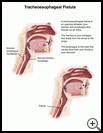
Tracheoesophageal Fistula
________________________________________________________________________
KEY POINTS
- A tracheoesophageal fistula is an opening between your trachea and esophagus. The esophagus and the trachea are next to each other in the back of the throat and chest, but normally they are not connected.
- The treatment for tracheoesophageal fistula is surgery to close the opening. You may need more than one surgery.
- Follow the full course of treatment prescribed by your healthcare provider. Ask your provider how to take care of yourself at home.
________________________________________________________________________
What is a tracheoesophageal fistula?
A tracheoesophageal fistula is an opening between your trachea and esophagus. The trachea is your windpipe. The windpipe is the airway that leads from the throat to the lungs. The esophagus is the tube that carries food from your throat to your stomach. The esophagus and the trachea are next to each other in the back of the throat and chest, but normally they are not connected.
What is the cause?
A tracheoesophageal fistula happens when something causes a hole to form between the trachea and esophagus. You have a greater risk of this happening if:
- You were in the hospital with a breathing tube for several days
- You have had a long-term serious illness
- You have had poor nutrition for a long time
- You have cancer of the esophagus
- You have had radiation treatment for cancer in the area of the neck
This is called an acquired tracheoesophageal fistula.
What are the symptoms?
Your symptoms may include:
- Chest pain
- Problems with eating and drinking
- Coughing
- Choking
- Difficult swallowing
- Noisy breathing
- Hoarse voice
- Food or liquids coming out of your nose when you swallow
- Losing weight because you are not able to eat enough to stay healthy
How is it diagnosed?
Your healthcare provider will ask about your symptoms and medical history and examine you. Tests may include:
- Endoscopy, which uses a slim, flexible, lighted tube passed through your mouth to look at your esophagus and stomach
- Chest X-ray
- CT scan
- Ultrasound, which uses sound waves to show pictures of the esophagus
- Bronchoscopy, which uses a flexible, lighted tube passed through your mouth and down into your lungs to see abnormal areas
How is it treated?
The treatment is surgery to close the opening. You may need more than one surgery.
How can I take care of myself?
Follow the full course of treatment prescribed by your healthcare provider.
Ask your provider:
- How and when you will get your test results
- If there are activities you should avoid and when you can return to your normal activities
- How to take care of yourself at home
- What symptoms or problems you should watch for and what to do if you have them
Make sure you know when you should come back for a checkup. Keep all appointments for provider visits or tests.

